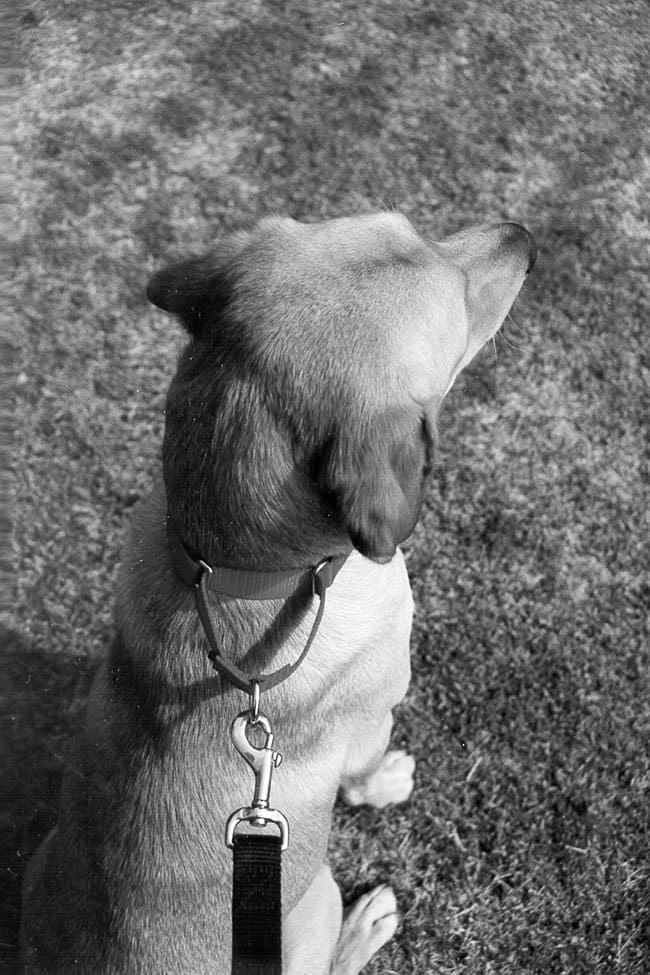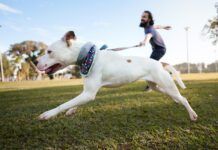[Updated November 15, 2017]
We put collars on our dogs for several reasons. Collars give us a convenient place to hang ID tags and licenses – very important for a dog’s health and safety should he ever get lost. They make a convenient handle when we need to restrain our dog for some reason – for safety, training, or to comply with leash laws or social convention. Finally, in some cases, collars are used as training tools, to reinforce cues to a dog; this is a compulsion-based application, not generally used in positive training.
In this article, we’e looking at dog collars primarily as a restraint tool, especially as a means to keep our dogs from slip-sliding away.
The best collars, in our opinion, are the simplest: standard flat buckle (or snap) collar in leather, nylon, or cotton. The standard fitting instruction is to allow space for two fingers between the dog’s neck and collar. This works fine for many dogs, and is the type of all-purpose collar we recommend for most occasions.

However, if a dog’s head is not much wider than his neck (a standard occurrence with slender-skulled sighthounds like Greyhounds and thick-necked breeds such as Pugs), a two-finger gap allows him to back easily out of his collar and be unrestrained. Even wider-headed dogs sometimes learn a swift duck-and-pull-back maneuver that wins them their freedom – and exposes them to the many hazards of stray dogdom, collarless and tagless.
If you have a Slippery Sam in your family pack, you might want to consider a limited-slip collar, sometimes called a martingale collar or a Greyhound collar (because they are often used on Greyhounds, whose owners are well aware of the collaring-challenge presented by their dogs’ anatomy). Unlike the choke chain (which is sometimes called a slip collar by those who are trying to improve the punishment-collar’s image) the properly fitted limited-slip cannot tighten enough around the dog’s neck to cause serious discomfort or damage to the trachea.
A Martingale’s Tightness is Limited
Limited-slip collars generally have one piece that goes around the dog’s neck and is adjustable for fitting. A second, smaller loop piece fits through the hardware on the ends of the neck piece and has a metal ring to which the leash is attached. When the neck piece is properly fitted, if the dog pulls, the loop piece tightens enough to prevent the collar from slipping over the head, but not enough to choke the dog.
A nice feature seen on some models is a “dead ring,” where a person can snap a leash for a normal, non-tightening grip, if they so desire. While some people fasten license and identification tags to this ring (better this than the ring that would tighten), we don’t recommend making a limited slip collar your dog’s full time collar.
While the limited-slip collar increases the level of security for escape-prone dogs, we should mention that, improperly used, the collar also increases certain hazards. Because these collars do tighten when pulled taut, don’t leave them on dogs who are left unattended or are turned loose to play with other dogs. With some models, dogs are at an increased risk of catching a front paw in the extra loop. Also, dogs should never be tied with a limited slip collar on. (Whole Dog Journal does not recommend tying dogs at all.)
A good limited-slip collar is sturdy and durable, safe, comfortable, easy to adjust, aesthetically appealing, and affordable. It will slip and release easily, and not tighten when it shouldn’t.
The adjustability of these collars is critical because the purpose is to have the collar loose enough to be comfortable, tight enough under tension to prevent the dog from slipping out of it, and, at maximum tightness, not tight enough to choke the dog.
We’ve rated several limited-slip collars on our 0-4 Paws scale based on our observations and preferences. The descriptions should help you determine which product would be the best choice for your dog.






Where is the list of ratings?